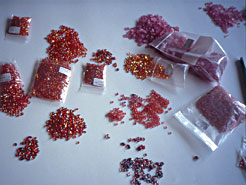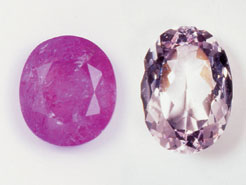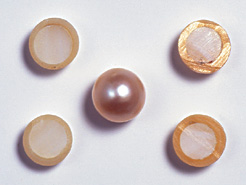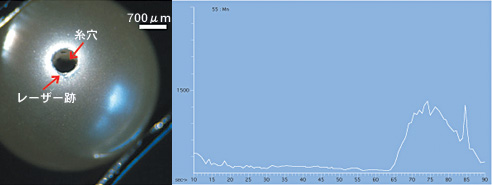| 4. Detection of Treatment Detection of heating processes aiming at colour improvement or alteration of a gemstone that have been performed more than several dozens of years (including so-called surface diffusion treatment using external additives of transitiosn metal element contributing directly to colouring) becomes almost possible within the use of common testing instruments. But recently a new diffusion treatment using a light element Be (beryllium) has been applied to corundum, resulting highly saturated orange, pink and yellow sapphire (Fig.5).
5. Highly Sensitive Analysis Gem Mineral Compositional Analysis Compositional analyses of a substance by XRF, SEM-EDX and EPMA do not have enough sensitivity, and for analyses of ultra-trace elements and light elements, the latest and highly sensitive analytical devices, SIMS and LA-ICP-MS, are utilised. To obtain more accurate result of quantitative values, minute area (100Κu) of a crystal has to be destructed. A new gem mineral variety of beryl group named gPezzotaiteh in 2003 was discovered in granitic pegmatite in the central Madagascar, Mandrosonoro district, and it was once called by a commercial name gRaspberylh (Fig.6).
Shell Material Analysis Pearls are classified broadly into two categories, freshwater pearl and saltwater pearl, and in recent years demand for nucleated freshwater pearl is increasing. A nucleus used for cultured pearl is produced generally from freshwater shell such as Genus Fusconaia from Mississippi River in the States and Anodonta Woodiana from China, and recently saltwater Tridacna Squamosa is also used (Fig.7).
6. Conclusion Several examples of our study on LA-ICP-MS analysis were introduced above. Analysis of ultra-trace elements by LA-ICP-MS method is very effective for locality identification of corundum and emerald, and it can be expected to do so for diamond and other gem materials. LA-ICP-MS analysis is also useful to detect diffusion treatment with light elements in corundum and identification of shell materials. Gemstone identification is supposed to face more complicated circumstances in the future, and the LA-ICP-MS analysis will become a vital analytical method to solve each of forthcoming problems. References Ahmadjan.A, H. Kitawaki, J. Shida, 2003. A new Technique for Corundum Analysis Using LA-ICP-MS (Inductively Coupled Plasma Mass Spectrometry) Instrument. Gemmology., Vol.34(11), No.410.,pp.4-7 (in Japanese, with insert of English translation). Ahmadjan.A, H. Kitawaki, 2003. Analysis on Cs Pink gBerylh using a Laser Ablation System with Inductively Coupled Plasma Mass Spectrometer (LA-ICP-MS). Gemmology., Vol.34(12), No411.,pp.24-26 (in Japanese, with insert of English translation). Ahmadjan.A and H. Kitawaki, 2004. Study of Origin Determination of Blue Sapphire using IA-ICP-MS Analysis. Gemmology., Vol.35(6), No417.,pp4-7 (in Japanese with insert of English translation). J. Shida, H. Kitawaki and Ahmadjan.A., 2004. Journal of The Gemmological Society of Japan., Vol.24, No.1-4.,pp.13-23. M. Resano, F. Vanhaeche, et al., 2003. Possibilities of laser ablation-inductively coupled plasma-mass spectrometry for diamond fingerprinting. J.Anal.At Spectrum., 2003, 18(10), 1238-1242. Wuyi Wang, Matt et al., 2003. Applications to Diamond Testing. Rapaport Diamond Report. September 5. |
||||||||||||||||||||||||||||||||||||||||||||||||||||||||||||||||||||||||||||||||||||||||||||||||||||||||||||||||||||||||||||||||
|
||||||||||||||||||||||||||||||||||||||||||||||||||||||||||||||||||||||||||||||||||||||||||||||||||||||||||||||||||||||||||||||||




